This is an original research article. Please cite as Katrina Navickas, ‘urbanisation’, http://protesthistory.org.uk/1-urbanisation.
Northern industrial towns underwent a ‘second urban renaissance’ during the later eighteenth century. The rage for ‘improvement’ transformed town centres, building new streets and squares, Palladian-fronted buildings and facilities for middle-class leisure, including theatres and assembly rooms.
‘Improvement’ of the built environment became institutionalised during the late eighteenth and early nineteenth centuries. Local authorities pressed for parliamentary legislation to enable sewers and water pipes to be laid, streets to be paved, lit, and cleaned, and such ‘nuisances’ as beggars and vagrants to be removed out of view. Improvement acts proliferated, reaching record levels in 1811 and 1822 and a peak in 1826. Of the forty English towns with populations over 11,000 in 1831, only four (including Wigan) had not undergone improvement acts.[1] The language of improvement filled pamphlets, town surveys, commission reports, and visitor guides. These writings and descriptions valorised the straightening of streets, the removal of obstacles and crumbling old buildings, and order and cleanliness.
[1] Joanna Innes and Nicholas Rogers, ‘Politics and Government, 1700-1840’, in Peter Clark et al, eds., Cambridge Urban History of Britain, 1540-1840 (Cambridge, 2000), p. 536; David Eastwood, ‘Local Government and Local Society’, in H. T. Dickinson, ed., A Companion to Eighteenth-Century Britain (Oxford, 2002), p. 50.
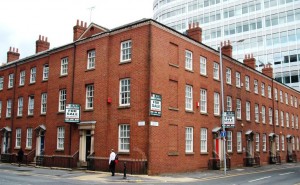
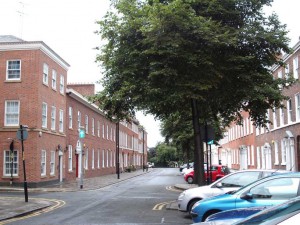
The ‘second urban renaissance’ was not the same as the ‘first’ earlier in the century. Manchester was not meant to be the new Warwick; Leeds was not the new Bath.
Indeed, when designs for the new commercial buildings in Leeds were hotly debated in 1825, one of the local newspapers commented that the difference between work and leisure should be obvious in the architecture: ‘we do not desire or expect that a public building in a manufacturing town, erected principally for commercial purposes, should exhibit the lightness, airiness and ornament of a House of Assembly in a fashionable watering place. Solidarity combined with taste, and utility with comfort, convenience and economy, are the objects chiefly deserving attention’. Hence it disapproved of the front elevation of the design, which ‘would rather become a ballroom at Bath, than a commercial newsroom at Leeds’.[1]
The more practical style of town housing for northern merchants and manufacturers built during the ‘second urban renaissance’ renders their surviving examples much less showy and remarkable than their counterparts elsewhere. Linstrum’s detailed study of Georgian architecture in the West Riding notes that: ‘unlike similar developments in London and Edinburgh, these terraces and squares were not designed with uniform facades to which the builder had to conform, but as they were all plain brick houses with more or less standard sash windows and pedimented doorcases, the effect was harmonious and domestic rather than grand’.[2] This can be seen in Wakefield, where the unassuming but elegant streets surrounding St. John’s Square (1791-5), with its dominant St. John’s church in the centre, still provide a respectable location for solicitors and doctors.
[1] Leeds Intelligencer, June-July 1825, cited in Grady, Georgian Public Buildings of Leeds, p. 116.
[2] D. Linstrum, West Yorkshire: Architects and Architecture (1978). pp. 102-3.
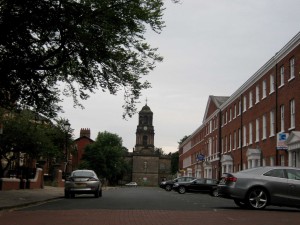
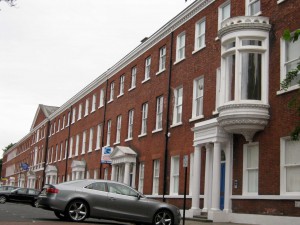
However, much of this improvement was haphazard and unplanned.
As Moore notes in his study of urban space in this period, ‘the streets and squares of a city were characteristic more of historical accidents and market forces than a reigning liberal moral order of progress and Benthamite rationalism’. Alehouses, ginshops, and ‘low’ theatres overwhelmed the new civic areas by their sheer ubiquity on every street corner.[1] The passing of improvement act after act, and local commissions’ order after order about obstructions and waste were testimony to the fact that improvers faced a continual battle against the realities of everyday urban life. Streets generally remained filthy and unpaved, rickety and dangerous buildings still threatened to collapse at any minute, and residents ignored the regulations. It was impossible to banish all evidence of human activity in the town: drovers’ cattle still came into the centre, butchers’ shambles still made the gullies stream with blood, and human waste still filled the streets. Nor did the middle-class assault on popular culture, which historians have charted in detail, reach its intended conclusion. Street life was as lively and dangerous as ever. Furthermore, with the rapid take up of steam power from the 1810s onwards, the new buildings were soon engulfed by the size and the smoke of industry and working-class housing.
[1] Moore, ‘Urban Space and Civic Identity’, 94.
There were only a few fully-planned towns. The Earl of Stamford and Warrington planned the new town centre of Ashton-under-Lyne and its rapidly expanding industrial neighbour Stalybridge.
The street plan was laid in grids on top of fields, and many of the mains streets were named after Stamford’s family members. The plots were leased to speculative builders, who had to fulfil aesthetic and size criteria for their new constructions.
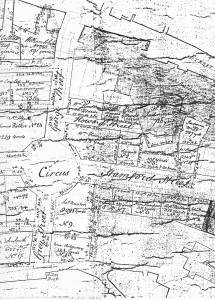
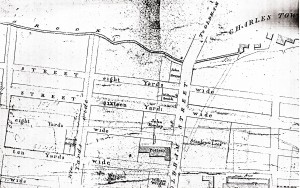
Urban improvement was neither a passive nor an organic process. Rather, it often reflected the politics of local power structures. As well as developing the physical and civic environment, the ‘principal inhabitants’ of towns developed the civic body politic. Improvement involved debates about what urban spaces should be regulated and who was to regulate them. Places involved a relationship of power, both in local governing structures and in relation to national government.
Civic and leisure buildings, though open to certain members of the public at certain times, themselves were not public spaces.[1] The Palladian facades of townhouses were designed uniformly to promote order and to separate private or domestic space from the public of the streets. The division into simple absolutes of public and private spaces only inadequately describes the ‘far more complex layering of space’, and especially its uses, both outside and inside the buildings.
[1] Stobart et al, Spaces of Consumption, p. 111, 113.
Newer urban histories have pointed out the ‘diffuse nature of power implied by the term governance’. James Vernon has emphasised how ‘civic landscapes’ were essential in the symbolism and ritualism of local elites, who used processions and ceremonies to project their vision of their authority: ‘These civic landscapes were not just urban backdrops for such performances, rather they were increasingly politicised themselves as rapid urbanisation placed a cumulative pressure on the organisation and use of space in towns and cities’. The town could be ‘read’ through its ‘public buildings and amenities, street names, statues and memorials’ which ‘articulated not only competing narratives of the community’s historical purpose and destiny, but also the role of different individuals and groups within those narratives’.[1]
[1] James Vernon, Politics and People, p. 49.
Who were the local elites?
Towns were officially run through formal institutions of authority, in the form of a corporation, council, court leet, parish, police commission, or other similar bodies. But underneath and in some cases above these administrative structures, ‘principal inhabitants’ could be found in more informal associations.
To be part of the local elite, a gentleman had to belong to myriad societies, sit on myriad committees, attend myriad dinners and other functions, and generally be seen to be doing something for the good of civic life. Given the Georgians and early Victorians’ obsession with committees, such roles could be parodied as ‘deputy-vice-principal-honorary-under-secretary’ of the ‘local district sub-committee’ of the botanical garden open every other Wednesday afternoon.
It is easy to find the names of the ‘principal inhabitants’ of a town: they expected, and were expected, to sign their names at the top of charitable subscription lists, addresses from the town to the king or nobility and petitions to parliament. They headed processions of the town body on feast days and other celebrations; they sat at the front at meetings, chairing and proposing and seconding the chair. During the later eighteenth century, as towns expanded and industrialized, ‘merchants and master manufacturers’ increasingly dominated the lists of these ‘principal inhabitants’.
Civic pride rested on commercial wealth, and the burgeoning middle classes were keen to make their mark on local, and thereby national, authority.

Hi where did you acquire the hawkyard & sidebottom maps of ashton from. Thanks Graham
Tameside Archives